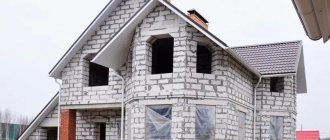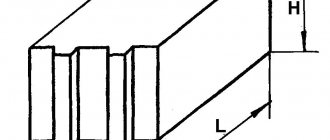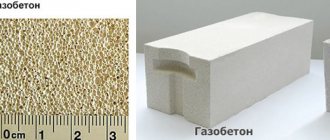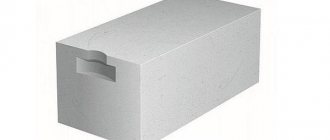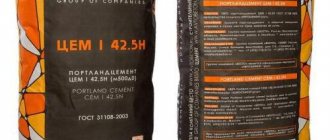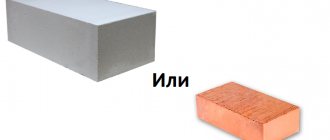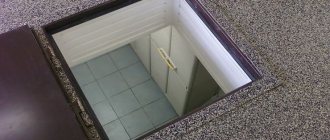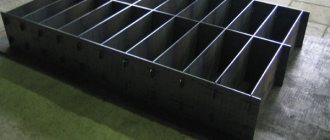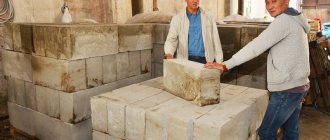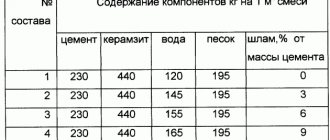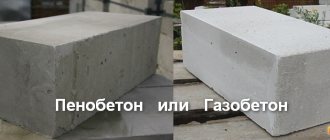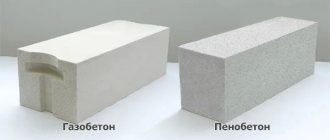Beton-House.com
Website about concrete: construction, characteristics, design. We combine the experience of professionals and private craftsmen in one place
Foam concrete, expanded clay concrete
The topic of comparing materials is gaining more and more popularity every year. This is due to the appearance on the market of an increasing number of new products that constitute worthy competition and the improvement by manufacturers of established technologies that attract more conservative consumers.
In this article we will consider the features and properties of wall materials. Expanded clay concrete or foam concrete: which is better? Let's analyze the characteristics and try to make the most correct choice.
- Overview of basic properties
- Features of foam concrete manufacturing
What is foam concrete
Now it’s time to figure out what foam concrete is and what characteristics it has. Let's start with the main qualities and properties that are of particular interest to developers.
Overview of basic properties
Let's use the table. Characteristics of foam concrete:
| Indicator name | Its meaning |
| Thermal conductivity | From 0.09 |
| Frost resistance | 15-100 cycles |
| Density | 300-1200 |
| Strength | From B 1.5 |
| Environmental friendliness | 2 |
| Fire resistance | Does not burn |
| Recommended minimum wall thickness | From 0.5 m |
| Water absorption | 10-16% |
Note! The thermal conductivity indicator is especially enviable for the material’s competitors. However, it is worth considering that it is typical for products in a dry state. With operating humidity, the numerical value increases. The maximum value can reach 0.4.
As in the case of expanded clay concrete, the ability to retain heat directly depends on the density of the products:
- Frost resistance is quite high, but foam concrete is still inferior to some materials.
- The density of the products makes it possible to erect buildings up to 12 meters in height.
- Water absorption is not so high. The ability to absorb moisture is somewhat reduced due to the special closed pore structure of foam concrete.
Now it’s worth paying a little attention to the composition of the material. Foam concrete is made from a mixture of cement, sand, water, foaming agent and specialized additives. The foaming agent provokes swelling of the solution, due to which the foam concrete has a cellular structure, which gives the material lightness and excellent thermal insulation qualities.
Important! Accordingly, the more pores, the lower the density and thermal conductivity.
Foam concrete structure
Types of material and products made from it
GOST has established more than one classification of foam concrete. Let's take a closer look at them.
Depending on the density, like expanded clay concrete, foam concrete can be of several types:
- Thermal insulation;
- Structural and thermal insulation;
- Structural.
Using the table, let us consider the main differences between the above types and the scope of application of the products.
The relationship between thermal conductivity and density of foam concrete, scope of application of products:
| Type of foam concrete | Average density indicator | Coefficient of thermal conductivity | Main Applications |
| Thermal insulation | 300-400 | 0,09-0,11 | It is used as a material for insulation, but cannot withstand loads due to the low density and strength of the material. |
| Structural and thermal insulation | 500-900 | 0,12-0,25 | It is used in the construction of walls and partitions, and is used in the construction of buildings several floors high. Most popular among private developers. |
| Structural | 1000-1200 | 0,26-0,34 | The most durable type of foam concrete. Able to withstand significant loads. It is used for the construction of load-bearing walls and structures. Needs additional insulation due to the high thermal conductivity coefficient. |
It is worth noting that there are also foam concrete blocks of higher density than structural ones; they are called structurally porous. Their density reaches 1500 kg/m3.
They are not widely used and are produced in small batches for individual orders. They are not regulated by GOST.
Depending on the hardening method, foam concrete can be:
- Autoclaved. Such products are processed in special chambers - autoclaves. It is there that the blocks reach technical maturity by exposing them to high temperature and pressure.
- Non-autoclave. Such blocks harden under natural conditions. They reach brand strength only after 28 days.
They are distinguished by lower strength, frost resistance, and greater fragility. Their color is more gray.
Depending on the type of binder, foam concrete can be made:
- On cement;
- On lime;
- On slag;
- On a mixed binder;
- On ash binder.
The content of the main component can reach over 50%. The minimum threshold is 15%.
According to the type of silica component, products can be:
- On sand (most often quartz);
- On the ashes;
- On other secondary industrial products.
It is also worth noting that foam concrete products may differ from each other in geometric deviations. Let's look at them using a table.
Categories of accuracy of foam concrete blocks:
| Name of deviation | First category blocks | Blocks of the second category | Blocks of the third category |
| To size | No more than 1.5 mm | No more than 2 mm | No more than 5 mm |
| Diagonally | No more than 2 mm | No more than 4 mm | No more than 7 mm |
| Chips in corners | No more than 3 mm | No more than 5 mm | No more than 8 mm |
| Chips on the ribs | No more than 3 mm | No more than 5 mm | No more than 10 mm |
Note! Exceeding the above deviations is permissible for no more than 5% of products in a batch for each indicator. No more than 2 broken corners are allowed in one block.
Foam concrete blocks can have a lined side (1 or 2). Such products do not require subsequent external finishing. In addition to blocks, foam concrete is also used in liquid form.
Basically, it is used:
- When insulating the roof;
- When pouring screeds and foundations under a heated floor;
- When creating monolithic structures
Advantages and disadvantages
Foam concrete has many positive qualities:
- Environmental friendliness and fire resistance.
- The low weight of the products will reduce the load on the building foundation.
- The large dimensions of the block contribute to a significant increase in construction speed.
- The material is easy to process, easy to saw and sand. This does not require the use of highly specialized tools.
- Due to the closed pore structure, water absorption is not so high and is about 10%.
- The cost of production is one of the lowest among cellular concrete.
- The frost resistance, density and thermal conductivity indicators are good enough for the construction of a practical and durable building.
- The vapor permeability of the material can create the most favorable microclimate. Foam concrete is able to absorb excess moisture and release it when the air is dry.
- The variety of sizes and large selection of manufacturers is also a significant plus.
- The ability to soundproof will protect those present in the building from extraneous sounds.
- Ease of manufacture and the possibility of self-release.
Advantages of foam concrete
Weaknesses also exist.
The main disadvantages are:
- Poor adhesion to finishing materials, which necessitates additional costs for primer, reinforcing mesh and expensive plaster mixtures.
- Poor fixation of fasteners and the need to use special hardware. To secure heavy objects, it is necessary to plan fastening points at the design stage and strengthen them.
- The presence of handicraft industries is another disadvantage. You can protect yourself from purchasing low-quality products only by checking the availability of appropriate documentation from the supplier in the form of certificates of conformity.
- Fragility of products. Foam concrete crumbles easily and breaks under mechanical stress.
- Blocks are prone to shrinkage, which often leads to cracks in the masonry.
Their disadvantages
Despite many advantages, foam blocks are not without disadvantages. These include the following points:
- insufficient bending strength especially in heat-insulating blocks;
- heterogeneity of structure when using a synthetic foaming agent;
- easy crumbling of the material due to insufficient mechanical strength, although nails and screws are screwed into foam concrete as into wood, they do not stay there well;
- possible shrinkage and the occurrence of cracks in structures when using freshly made (less than 1 month ago) foam blocks, since they must settle; without this, their strength indicators are not sufficient.
- restrictions on the use of certain types of finishes. Due to the hygroscopicity of foam concrete, it is necessary to choose a finishing option that leaves a gap between the wall and the cladding;
- production of material by many small manufacturers who do not always keep up with the technology.
- the possibility of changing the structure of foam concrete due to a chemical reaction during the interaction of the cement composition and carbon dioxide, as a result of which chalk is formed and the block becomes brittle.
By the way! When purchasing a batch of blocks, it is advisable to make sure that there is a quality certificate issued by the manufacturer. To check the brand strength of the block, you can drive a 10 cm long nail into it. If it is not removed with bare hands, then the strength corresponds to the standard.
When deciding which block is better, foam concrete or expanded clay concrete, you should not forget about the disadvantages of the latter, because, of course, it also has them. The disadvantages of this material include:
- Sufficient load on the foundation. Although blocks made of expanded clay concrete weigh less than bricks, they are still heavier than wall foam blocks. Consequently, it will not be possible to build a house from them on a lightweight foundation.
- Expensive delivery of block material.
- Difficulties in processing blocks. Cutting them with a power saw is fraught with the appearance of chips on the surface.
- Possible inaccuracies in the sizes of blocks made even by large manufacturers.
- Not a smooth surface due to sagging and depressions formed by expanded clay gravel. These defects make it impossible to perform masonry with thin seams.
Comparison of materials
Now let's compare the materials with each other and find out: expanded clay concrete blocks or foam blocks - which is better?
Let's use the table. What is better expanded clay concrete or foam concrete:
| Indicator name | Comparison and analysis of the indicator |
| Frost resistance | In this indicator, expanded clay concrete definitely wins. It's typical for him. As already mentioned, up to 200 freeze-thaw cycles. |
| Density | It is also superior in density to expanded clay concrete. The numerical value can reach 2000 kg/m3. |
| Thermal conductivity | But foam concrete wins in thermal conductivity, which is directly related to the lower density of the material. |
| Shrinkage | Shrinkage is not typical for expanded clay concrete; foam concrete, in turn, cannot boast of this. |
| Complexity of processing and speed of construction | Expanded clay concrete is difficult to process. As for the speed of construction, it seems that foam concrete is somewhat ahead of its competitor. However, based on the size, the dimensions of both products are quite large. |
| Product price | Foam concrete is cheaper, about 10-15% depending on the region and manufacturer. |
| Environmental friendliness | Both materials do not contain toxic substances and are absolutely safe for others. |
| Prevalence, scope of application | In general, both materials are common. However, expanded clay concrete, in this case, is still worth highlighting. It is used in the construction of foundations and plinths, which is not typical for foam concrete. Based on this, its scope of application is wider. |
| Water absorption | Both one and the second material are capable of absorbing moisture. |
| Variability of finishes | Walls made of expanded clay concrete and foam concrete can be finished using almost any material. The main thing is to observe technical validity. |
| Additional expenses | Additional costs are expected in greater quantities during the construction of foam concrete. It has significantly worse adhesion than expanded clay concrete. |
| Difficulty of installation | The installation technology is extremely similar, so we can say that in this case there is no winner. |
| Complexity of the production process | Both expanded clay concrete and foam concrete are not difficult to manufacture. Both materials can be produced independently. In this case, enormous costs will not be required. |
As you can see, each material is good in its own way. And if you had to compare expanded clay concrete and foam concrete, then the choice is probably not easy to make. To make the right decision, you should decide which qualities are most important to you - only in this case, answer the question “which is better?” it will be much easier.
Advantages of blocks
Foam blocks are characterized by a large list of advantages:
- light weight due to the air content in the structure;
Important! Due to the sufficient lightness of the material, the house will not be heavy. This means there will be no significant pressure on the foundation either. Therefore, pouring the foundation must be done taking this factor into account.
- successful combination of strength and low density;
- high level of noise absorption due to the porous structure;
- low thermal conductivity due to a large number of pores filled with air;
- fire resistance and environmental friendliness, thanks to the mineral base;
- low hygroscopicity, closed pore volume prevents the penetration of moisture into the block;
- high frost resistance is due to low hygroscopicity;
- Low price due to simple production technology. When comparing the price of foam blocks with the cost of traditional materials, the difference turns out to be significant;
- low material consumption.
We should start talking about the advantages of expanded clay concrete blocks with the fact that this is the most natural material from an environmental point of view. The structure of the block consists of a large number of expanded clay granules, which are burnt expanded clay and Portland cement with sand, filling the intergranular space. In addition, the advantages of expanded clay concrete blocks include:
- Low thermal conductivity due to the fact that clay retains heat well.
- Excellent vapor barrier of modules.
- High levels of noise insulation due to the porous structure of expanded clay gravel.
- A block made of expanded clay concrete, having already high strength, becomes even stronger over the years.
- The durability of expanded clay concrete structures, which is ensured by sufficient strength of the material.
- High frost resistance after 50 cycles, loss of strength 6%.
- The highest fire safety class is A1.
- Light weight, allowing the construction of wall structures that are 2.5 times lighter than brick walls.
- Combination with all possible types of finishes.
Production cycle overview
Since we have already compared the qualities and properties, it is worth briefly considering the manufacturing features of both materials and analyzing the level of complexity and amount of labor costs. Perhaps, when choosing, this will become a powerful argument.
Features of foam concrete manufacturing
Foam concrete can be produced in several ways:
- Classic technology;
- Barotechnology;
- Dry mineralization method.
Classic technology is the most common.
The stages of work are as follows:
- A foaming agent is introduced into the cement mortar;
- The prepared solution is poured into molds;
- Semi-finished products are subjected to stripping (when manufactured in a single layer, they are pre-cut into standard sizes);
- Processed in an autoclave or kept for 28 days using a non-autoclave production method.
The dry mineralization method differs in that the ingredients are mixed dry.
The barotechnology method involves supplying foam through high pressure, without the use of a foam generator. The method is often used during continuous production on a construction site.
The equipment can be used in several types:
- Mini line. Differs in the minimum daily volume of production. Suitable for home production and small businesses.
- A stationary line is more expensive; you can choose the equipment yourself. Productivity is higher, labor costs are lower.
- The conveyor line is the most automated. It is used in large-scale production, the daily production volume can reach 200 m3. Features minimal human intervention.
Products made using this line are of higher quality and geometrically smooth.
Production of expanded clay concrete: review of equipment and step-by-step analysis of the work process
To produce expanded clay concrete, you will also need certain equipment.
The lines can be either fully automated or partially manual (mini-line). A standard set of machines, tools and raw materials suitable for home use includes:
- Concrete mixer;
- Vibropress;
- Cement, sand, water, expanded clay and plasticizer (liquid soap can be used);
- Container in the form of a bucket or trough.
The sequence of work looks like this:
- The solution is mixed. Water is poured in first, followed by all the ingredients;
- The finished solution should have a consistency similar to sour cream;
- The next step is molding. To do this, you will need vibrating compaction equipment, which, using vibration, compacts the solution.
- Excess mixture is removed with a special knife;
- The metal plate with the products is dried for several days, after which they are unmolded;
- Like foam concrete, expanded clay concrete products need to gain strength within 28 days.
- It is also worth mentioning the presence on the construction industry market of a combined material called expanded clay foam concrete.
- It is manufactured using modern technology. The essence of the method is as follows: components in the form of water, expanded clay, cement and foaming agent are sequentially loaded into the mixer. The latter is supplied in the form of a solution by spray.
- This innovation relates to the production technology of panels for walls made of expanded clay foam concrete.
- The main goal of such production is to obtain a finely porous solution structure with closed pores, which undoubtedly led to a decrease in thermal conductivity and density, due to an increase in the amount of air in the solution and a uniform distribution of cells.
Recommendations for the production of expanded clay foam concrete products
Briefly about the profitability of production of both materials, possible prospects
If we talk about profitability, then producing expanded clay concrete and foam concrete is economically profitable.
The result largely depends on a number of factors, which include:
- Features of the region, including purchasing power;
- Investments in business, type of equipment and productivity;
- Speed of sales of finished products;
- Business expenses, number of employees and much more.
In any case, for proper planning, it is recommended to first draw up a business plan that will take into account all possible income and expenses and will be able to predict the approximate outcome.
Even if we assume that the cost of one m3 of expanded clay concrete is about 2,200 rubles, and it can be sold for 3,200, then, provided that 30 m3 are produced per day (this is a small volume) and sold, you can earn 900,000 in a month. This, you see, good income.
A set of budget equipment will cost approximately 800,000. It is easy to calculate that in an optimistic scenario, it can pay for itself in 1-2 months.
Specifications and Dimensions
The main division of cellular concrete, which includes foam concrete, is carried out according to strength class and density grade. When comparing which is better - foam blocks or expanded clay blocks, you must know this classification.
- Strength is indicated by the letter “B” and a numerical index, which indicates the maximum permissible compressive load in MPa. Example: class B2.5 - the block can withstand a force of 2.5 MPa. 1 MPa = 10.2 kgf/cm2.
- Density is indicated by the letter “D” , the numbers indicate the weight of 1m3 of the substance. Example: D600 - 1 m3 of such foam concrete weighs 600 kg.
- Concrete containing filler, in this case expanded clay, is marked with the letter “M” , the number characterizes the force that the material must withstand in kgf/cm2.
Example: M75 - maximum load 75 kgf/cm2.
The ratio of concrete markings for classes “B” and grades “M”
Expanded clay block
The dimensions of these products are divided into two types - for walls and partitions.
The ratio of thermal conductivity and density of expanded clay blocks
The main parameters of expanded clay concrete blocks largely depend on the amount of expanded clay concrete in the block, the volume and distribution of voids.
Fluctuations in the characteristics of expanded clay blocks
With all manufacturing options, strength and thermal conductivity are at a fairly high level.
Foam block
Cellular blocks have a much wider range of sizes, which allows for less cutting of additional elements. When comparing whether a foam block or an expanded clay block is more convenient to work with, preference should be given to the first type.
A small part of the possible sizes of foam blocks is given
The characteristics of foam blocks are more tightly grouped by density grade. This feature makes it easier to choose the right look.
Characteristics of foam blocks
Summary of characteristics comparison
When comparing expanded clay blocks or foam blocks, which is better in terms of parameters, it makes sense to compare them with other materials
Characteristics of various materials
Wall masonry using both materials
The masonry technology for constructing walls from both materials is extremely similar, so we will consider the general principles and rules.
The stages of work are as follows:
- Laying blocks always starts from the corners: the blocks are installed, and a thread is pulled between them, serving as a guide.
- It is recommended to lay the first row on mortar for better adhesion to the base.
- Experts advise laying the second and subsequent rows using specialized adhesives. The thickness of the seam should be small in order to reduce cold bridges.
- If there is a gap in the row, the block must be cut to the required size.
- Control and adjustment of the evenness of the masonry is carried out using a building level and a rubber hammer. This should be done as often as possible, as the solution sets quickly. and it is not possible to disassemble the finished masonry.
- Each subsequent row is laid with a seam offset of 25-30%.
- The first and every fourth row produce reinforcement.
- The final stage is the installation of an armored belt.
Some tips when carrying out masonry work:
- When preparing the solution yourself, keep in mind that it should not be excessively liquid;
- The grade of cement must be at least M400;
- There should be no cracks or gaps;
- It is definitely worth pre-waterproofing the foundation.
- When ligating blocks, you must use the rules prescribed in the technical documentation.
- It is not recommended to mix a large amount of solution at once. It sets quickly, you need to have time to work it out.
The video in this article will tell you more about the stages of laying expanded clay concrete and foam concrete blocks.
Laying expanded clay concrete blocks
Technical characteristics of expanded clay concrete blocks
If we delve deeper into the process of manufacturing expanded clay concrete, we recall that this building material is produced by vibrational semi-dry compaction of a mixture that consists of prepared clean water, a proportion of cement (not lower than M400), sand (coarse or medium fraction), expanded clay itself and special additives ( plasticizers). When making expanded clay concrete, you can use baked foam clay (expanded clay) of different sizes, but it is worth remembering that when using very large fractions you will gain in the weight of the product, but at the same time seriously lose in its strength, i.e. In any case, such a expanded clay block cannot be called good.
Expanded clay concrete blocks: features
The final shape of expanded clay concrete resembles a brick, but it can be either hollow or solid inside. For example, integral expanded clay concrete can withstand heavy loads, which is why it is used for the construction of load-bearing walls. As for hollow expanded clay concrete, it is used for the construction of walls. At the same time, the use of hollow expanded clay concrete reduces the overall weight of the structure, thereby reducing its strength. But at the same time, the thermal insulation properties of such a wall increase significantly.
What is cheaper: expanded clay block or gas block: selection criteria
Aerated concrete blocks are cheaper than the average price tag for expanded clay concrete. The cost is affected by the composition of the mixture and the number of voids in the product. But the final cost of construction changes if we take into account all the work associated with the construction of walls. For example, to eliminate imperfect masonry, more mortar and plaster are needed; on the other hand, there is no need for anchors; any heat-insulating material can be used. There will also be a difference in the cost of delivering construction materials to the site. Aerated concrete weighs less, the cost of transporting m3 will be lower than when transporting expanded clay concrete.
To save money, you can make expanded clay concrete blocks yourself. This option is suitable for experienced builders familiar with production technology. Any violation of the composition or production technology will negatively affect the consumer properties of the material. The advantage is that for production it is enough to have molds and a concrete mixer.
Ease of production is not only an advantage, but also a disadvantage. Production requires minimal investment, which gives rise to many handicraft manufacturers who do not always comply with technology.
The production of autoclaved aerated concrete is a complex technical process that requires expensive equipment. The quality of blocks is regulated by state standards; fakes are rare.
To ensure the reliability of the material, choose blocks installed on pallets, sealed in factory-made shrink film. Before purchasing, it would be a good idea to check the quality certificates for the purchased batch.
It is important to know that high-quality aerated concrete and expanded clay concrete are sold in batches of uniform color. The blocks should not have chips, cracks, visible deformations, or oil deposits.
Expanded clay concrete
For production, cement mortar with the addition of expanded clay granules is used. To harden, the mixture is poured into ready-made molds; to obtain the final product, they are kept at normal temperature for at least 28 days.
Main advantages:
- Low cost allows you to save on construction;
- High strength and thermal insulation;
- Good sound insulation;
- Resistance to low temperatures and long-term operation without loss of properties;
- Moisture resistance;
- Lightweight expanded clay blocks;
- Environmental Safety;
- After construction, there is little shrinkage of the building and no cracks;
- Can be used for load-bearing walls and partitions;
- They withstand mechanical processing well. They can be nailed and drilled easily;
- The material does not rot. the formation of fungi and mold;
- Houses made of expanded clay blocks are durable;
- One block can replace 7-11 bricks. The cost of houses is 40% less than brick ones.
The material also has some disadvantages:
Advantages of aerated concrete
Scheme for the production of aerated concrete on an industrial scale
- Aerated concrete has low weight, an ideal surface and the shape of a cast block or monolithic structure.
- Ease of installation. Aerated concrete blocks can be fastened to each other with special glue. When working inside an apartment, using blocks allows you to avoid excess dirt.
- Aerated concrete has a high level of thermal insulation.
- Aerated concrete blocks are easy to cut and polish. Transporting the blocks does not create any special problems.
- Aerated concrete has high vapor permeability. Excess steam easily penetrates through the block wall.
- Aerated concrete is an environmentally friendly building material that does not pose a health hazard and contains no toxic substances.
- Aerated concrete and aerated concrete blocks allow the construction of structures that do not require additional insulation.
- With the low weight of aerated concrete and blocks made from it, the walls are 3 times lighter than brick and 1.5-1.7 times lighter than expanded clay.
- Aerated concrete is suitable for installing internal partitions.
- Partitions made of aerated concrete and aerated concrete blocks do not require additional surface leveling.
When is it better to use foam block
Organic foam block is suitable for building garages, cottages (up to 2-4 floors), sheds, outbuildings, workshops, bathhouses - almost any low buildings. Both residential and utility.
Artificial foam block - has a hazard class of 4, like roofing felt. And less durable than organic, but cheaper. If you want to use it, then it’s better to do it in the fresh air - in the outer walls (without contact with the internal atmosphere of the house). Or in well-ventilated buildings - agricultural sheds, garages, workshops.
Here's why foam block is good:
- It is lightweight (on average 21 kg per piece), easy to install, does not require complex equipment for installation (a trowel and cement mortar are needed), has very good thermal insulation - better than expanded clay blocks, bricks and wood.
- It does not rot or burn, it “breathes”.
- Absorbs moisture - 14%.
- A building made of foam block usually does not need a monolithic foundation - the material is relatively light. Construction time is reduced, but quality remains the same.
- Floats in the water.
- Durable - will last about 100 years.
